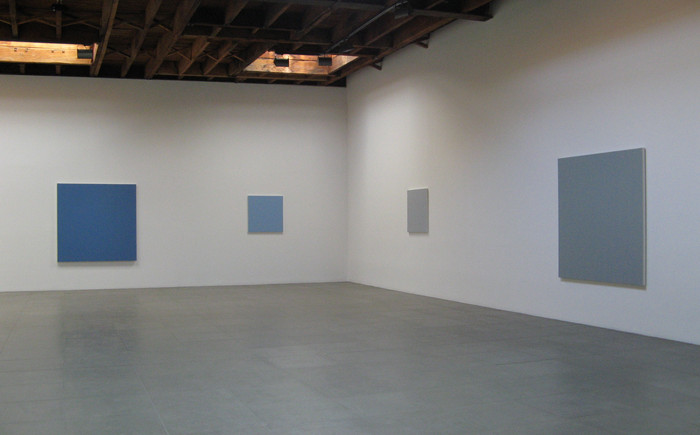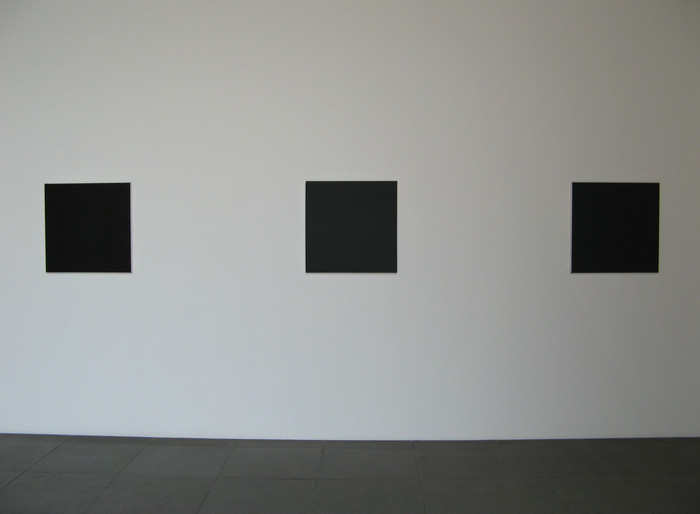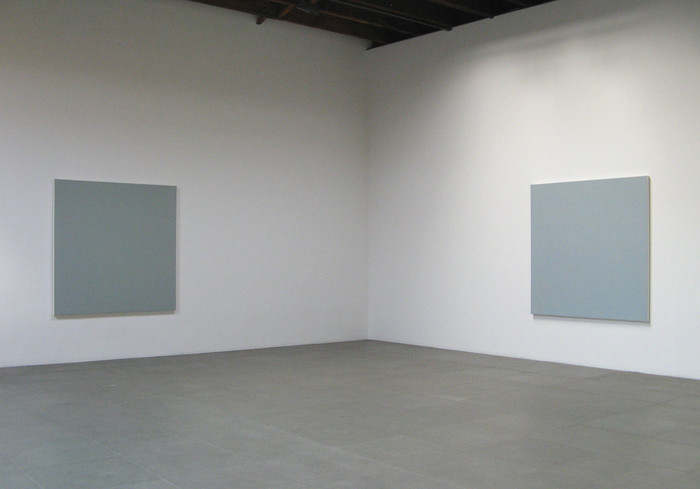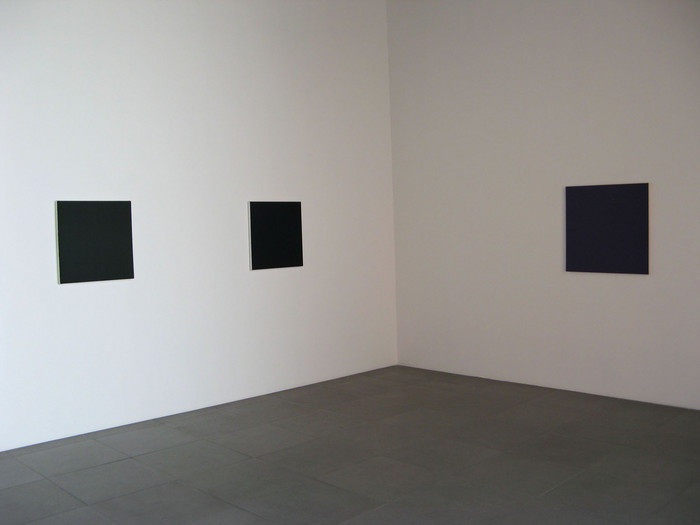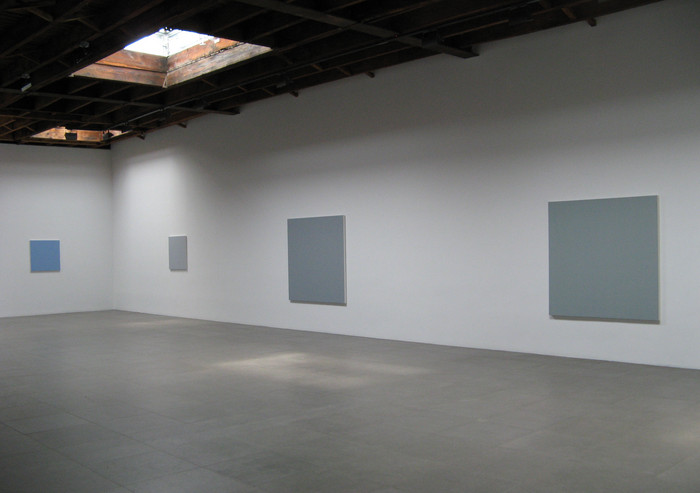Rudolf de Crignis: Paintings 1992 to 2006 @ 526 West 29th Street
24 Apr - 14 Jun 2008
Peter Blum is pleased to announce the exhibition Rudolf de Crignis: Paintings 1992 to 2006, opening on April 24th at Peter Blum Chelsea, 526 West 29th Street, New York. This is the first one-person exhibition since Rudolf de Crignis passed away in 2006 and his third solo show with Peter Blum Gallery.
Rudolf de Crignis: Paintings 1992 to 2006 traces Rudolf de Crignis’ development as a painter from the early 1990s to 2006. The first gallery contains 5 works from 1992 to 1995, which already feature de Crignis’ canvas shape of choice – the square – and range in color from black to brown to green to purple to blue. This grouping investigates De Crignis’ early experiments in coloration and surface layering. The paintings in the main gallery, each measuring either 30 x 30 or 60 x 60 inches, highlight De Crignis’ unrelenting investigation into the possibilities of ultramarine and grey as his primary colors.
On first glance, de Crignis’ paintings appear to be a single hue – for example ultramarine or grey. However, each painting is built up by multiple layers of semi-transparent paint in a variety of different colors with each glaze covering the entire canvas. De Crignis applied the paint with a wide brush, methodically alternating horizontal and vertical brushstrokes with each layer. His starting point was a finely worked white gesso surface on which the crosshatched layers of paint in colors as diverse as Cinnabar green, Scheveningen orange and Nickel yellow add up to a seemingly monochrome surface. In some paintings we can find up to 60 layers. As the light hits the surface of the painting it penetrates the translucent color coatings and bounces back from this white grounding surface, creating the effect of an infinite depth of space.
Born in 1948 in Winterthur, Switzerland, de Crignis studied fine art at the Form + Farbe School for Art and Media Design in Zürich from 1974-1976 and later at the Academy of Fine Arts in Hamburg, Germany. His main focus in these early years was in the areas of video, photography, and performance art. In 1985, a studio fellowship allowed de Crignis to live and work in New York City. It is here where he shifted his attention to painting, citing the influence of such painters as Ryman, Reinhardt, Martin and Newman and the movements of abstract expressionism and minimalism.
Solo exhibitions include: Stiftung für Konstruktive und Konkrete Kunst, Zürich, Switzerland, 1991; Kunsthalle Winterthur, Switzerland, 1995; Centre d’art contemporain de Demigny, France, 1996; Arthothek Cologne, Germany, 2001; Kunstmuseum Bonn, Germany, 2003; CCNOA Brussels, Belgium, 2004; Scheizerische Nationalbibliothek, Bern, Switzerland, 2006. De Crignis’ work is in numerous public collections, including the Indianapolis Museum of Art; the Chazen Museum of Art; the Albright-Knox Art Gallery; the Berkley Art Museum; the Fogg Art Museum at Harvard University; the Rose Art Museum at Brandeis University; the Yale University Art Gallery; the Kunsthaus Aarau, Switzerland; the Kunsthaus Zürich, Switzerland; the Lenbachhaus Munich, Germany; Kolumba, Cologne, Germany; and the Kunstmuseum Bonn, Germany.
This exhibition is accompanied by a publication with a text by Linda Norden.
For additional information and photographic material please contact Simone Subal at chelsea@peterblumgallery.com. Hours: Tuesday to Saturday 10am to 6pm.
Rudolf de Crignis: Paintings 1992 to 2006 traces Rudolf de Crignis’ development as a painter from the early 1990s to 2006. The first gallery contains 5 works from 1992 to 1995, which already feature de Crignis’ canvas shape of choice – the square – and range in color from black to brown to green to purple to blue. This grouping investigates De Crignis’ early experiments in coloration and surface layering. The paintings in the main gallery, each measuring either 30 x 30 or 60 x 60 inches, highlight De Crignis’ unrelenting investigation into the possibilities of ultramarine and grey as his primary colors.
On first glance, de Crignis’ paintings appear to be a single hue – for example ultramarine or grey. However, each painting is built up by multiple layers of semi-transparent paint in a variety of different colors with each glaze covering the entire canvas. De Crignis applied the paint with a wide brush, methodically alternating horizontal and vertical brushstrokes with each layer. His starting point was a finely worked white gesso surface on which the crosshatched layers of paint in colors as diverse as Cinnabar green, Scheveningen orange and Nickel yellow add up to a seemingly monochrome surface. In some paintings we can find up to 60 layers. As the light hits the surface of the painting it penetrates the translucent color coatings and bounces back from this white grounding surface, creating the effect of an infinite depth of space.
Born in 1948 in Winterthur, Switzerland, de Crignis studied fine art at the Form + Farbe School for Art and Media Design in Zürich from 1974-1976 and later at the Academy of Fine Arts in Hamburg, Germany. His main focus in these early years was in the areas of video, photography, and performance art. In 1985, a studio fellowship allowed de Crignis to live and work in New York City. It is here where he shifted his attention to painting, citing the influence of such painters as Ryman, Reinhardt, Martin and Newman and the movements of abstract expressionism and minimalism.
Solo exhibitions include: Stiftung für Konstruktive und Konkrete Kunst, Zürich, Switzerland, 1991; Kunsthalle Winterthur, Switzerland, 1995; Centre d’art contemporain de Demigny, France, 1996; Arthothek Cologne, Germany, 2001; Kunstmuseum Bonn, Germany, 2003; CCNOA Brussels, Belgium, 2004; Scheizerische Nationalbibliothek, Bern, Switzerland, 2006. De Crignis’ work is in numerous public collections, including the Indianapolis Museum of Art; the Chazen Museum of Art; the Albright-Knox Art Gallery; the Berkley Art Museum; the Fogg Art Museum at Harvard University; the Rose Art Museum at Brandeis University; the Yale University Art Gallery; the Kunsthaus Aarau, Switzerland; the Kunsthaus Zürich, Switzerland; the Lenbachhaus Munich, Germany; Kolumba, Cologne, Germany; and the Kunstmuseum Bonn, Germany.
This exhibition is accompanied by a publication with a text by Linda Norden.
For additional information and photographic material please contact Simone Subal at chelsea@peterblumgallery.com. Hours: Tuesday to Saturday 10am to 6pm.

